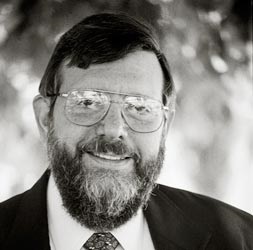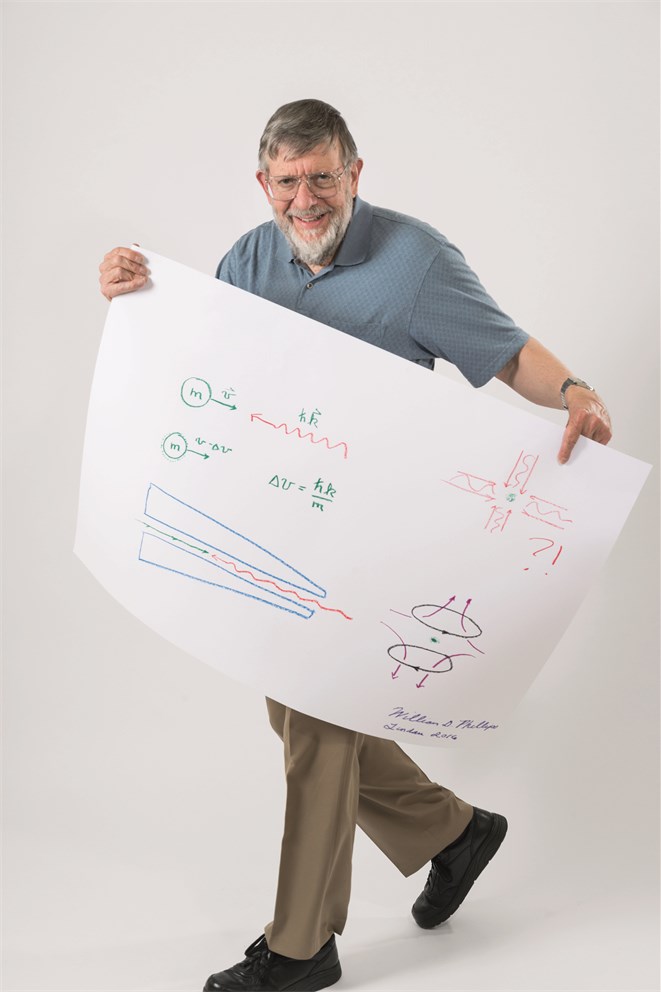
William Daniel Phillips is an American physicist who shared the 1997 physics prize with Steven Chu (US) and Claude Cohen-Tannoudji (France). All three developed methods of cooling and trapping atoms using lasers. At room temperature atoms and molecules in the air move in random directions at a few hundred m/s. Such high velocities make it difficult to perform precise measurements on atomic gases at ordinary temperatures. Conventional refrigeration of the gas would lower the atom’s velocity, but at temperatures sufficiently cold to make the most precise measurements, the gas would condense into a liquid or a solid. The three laureates, working independently but in close communication, developed methods to cool gases by pushing on the atoms with laser light, and to trap them, suspending them in space using laser light or magnetic fields.
Phillips was born in Wilkes-Barre, Pennsylvania, in 1948. He was a keen reader and, like many Nobel laureates, played with erector sets, microscopes and chemistry sets as a child. In 1956, the family moved to Butler, near Pittsburgh, and William entered an experimental ‘accelerated’ class, learning French and advanced mathematics. In 1966 he progressed to Juniata College, learning physics with calculus under an inspiring teacher, Ray Pfrogner, and under the instruction of Wilfred Norris starting a laboratory course normally taken by third-year students. Phillips proved a point by being the first physics student from his school to be accepted to Princeton – but instead decided to go to MIT, studying under Dan Kleppner. Just before going to MIT he married his high school sweetheart, Jane Van Wynen, and the couple moved to Boston. They have two children.
For his thesis research Phillips measured the magnetic moment of the proton in water (to date, his is still the most accurate determination), and went on to explore the potential of some ‘new toys’ – tunable dye lasers. He embarked on an experiment to study the collisions of laser-excited atoms. After completing his thesis work in 1976 he continued to work on collisions and attempted some work on Bose-Einstein condensation. In 1978 he moved to the National Bureau of Standards (later NIST), in Gaithersburg, Maryland, where he began to work on laser cooling.
Working with Hal Metcalf, and others he developed methods for slowing an atomic beam using the force exerted by laser light. Then, building on Chu’s work, Phillips improved the measurement of the laser-cooled atoms, which reached a temperature six times lower than the theoretical limit. Cohen-Tannoudji, Chu and their colleagues refined the theory, and they and Phillips found methods of cooling atoms to even lower temperatures. This was a major step on the path to achieving Bose-Einstein condensation in atomic gases (by Carl Wieman, Eric Cornell and Wolfgang Ketterle – created Nobel laureates in 2001). Today, Phillips and his colleagues at the Joint Quantum Institute (a cooperation of NIST and the University of MD) use ultra-cold atoms to study a variety of problems including quantum simulation, quantum information processing, and atomtronics.
Exhibition "Sketches of Science" by Volker Steger - Locations & Dates

By Volker Steger
„What can I do for you?!“ Well, please make me a sketch of your Nobel discovery! He does, giving me an idea of the precision it takes to stop an atom cold. In the studio, he walks towards me and I stop him with my strobes! A small, feat, I know. But it makes one think about the fact that light can ideed slow motion in the world of atoms. Amazing.
